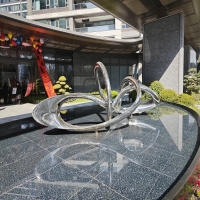Welcome to the website for landscape facilities products and knowledge.
What are the best practices for anchoring a landscape bar counter to prevent movement in high winds?
Securing landscape bar counters against high winds requires engineering precision and proper installation techniques. The most effective approach begins with understanding wind load dynamics and implementing robust anchoring systems that address both uplift and lateral forces.
For permanent installations, concrete foundations provide superior stability. Dig footings below frost line depth, typically 36-48 inches, with diameter proportional to the bar's size. For a standard 6-foot bar counter, 18-inch diameter footings at each support point ensure adequate mass. Embed galvanized steel anchor bolts into the wet concrete, aligning precisely with the bar's support structure. Use epoxy anchoring systems for existing concrete surfaces, drilling holes 1/4 inch deeper than the anchor length for proper adhesive distribution.
Structural connectivity proves crucial in wind resistance. Install continuous steel frames within the bar structure, welding all joints rather than relying on mechanical fasteners alone. Incorporate diagonal bracing on all sides to prevent racking, using stainless steel cables or angled steel supports. For bars attached to buildings, use expansion anchors into structural walls rather than siding or decorative materials.
Material selection significantly impacts wind resistance. Choose solid surface materials like granite or quartz rather than hollow composite options. For wooden constructions, use pressure-treated lumber rated for ground contact and apply waterproof adhesives at all joints in addition to mechanical fasteners. Install wind baffles beneath the countertop to reduce uplift forces without compromising aesthetics.
Regular maintenance ensures ongoing stability. Inspect anchor points seasonally for corrosion or loosening. Check for soil erosion around foundations that might compromise stability. Consider secondary anchoring systems like ground screws or helical piles in particularly vulnerable locations. For temporary installations, use weighted bases with sand or water ballast, ensuring at least 100 pounds per linear foot of counter length.
Professional installation remains recommended for high-wind areas. Certified contractors can calculate specific wind load requirements based on local building codes and environmental factors. They implement engineering solutions like moment-resisting foundations or seismic-grade connectors that exceed standard requirements. Always obtain proper permits and inspections to ensure compliance with regional wind resistance standards.
Implementing these best practices creates landscape bar counters that withstand winds exceeding 100 mph while maintaining aesthetic appeal and functionality for outdoor entertainment spaces.
Related search:

Recommendation
Abstract art sculpture, stainless steel metal sculpture, large-scale water feature sculpture